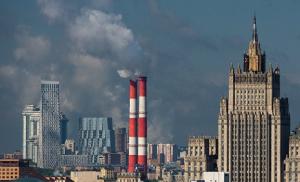National parks of Greece. Olympus
Greece is fragmented into small tracts of land and has many ecosystems. The bulk of the population - almost two thirds - lives in large cities along the coast. Tourist flows are directed to the same places, which increase during the holiday season. The pressure on fragile ecosystems is also increasing. In connection with the intensive use of natural resources in the country, protected zones, wildlife sanctuaries, parks, forests and reserves are being created. They help maintain an ecological balance. The Greeks are very sensitive to the pristine nature of their native land, as well as to historical monuments. National parks of Greece are natural attractions of the country of interest to tourists and vacationers.
 During your vacation in Greece, you will hear more than once about the twelve gods of Olympus, who were part of the Greek pantheon. All of them lived on the highest mountain range, which is now located in the UNESCO-protected area of the Olympus National Park. The park is located in the east of the mainland, near Thessaloniki, in the region of Thessaly. It was opened in 1938 and covers an area of 3,933 hectares. Every year, those who wish take long walks and conquer the peaks, admiring the mesmerizing views from the heights. The natural complex includes mountain rivers, gorges, forests of deciduous and coniferous trees, which saturate oxygen with freshness and a healing aroma. Above the forest level, there are alpine valleys. Lime soil absorbs excess moisture and makes the climate drier than on the coast.
During your vacation in Greece, you will hear more than once about the twelve gods of Olympus, who were part of the Greek pantheon. All of them lived on the highest mountain range, which is now located in the UNESCO-protected area of the Olympus National Park. The park is located in the east of the mainland, near Thessaloniki, in the region of Thessaly. It was opened in 1938 and covers an area of 3,933 hectares. Every year, those who wish take long walks and conquer the peaks, admiring the mesmerizing views from the heights. The natural complex includes mountain rivers, gorges, forests of deciduous and coniferous trees, which saturate oxygen with freshness and a healing aroma. Above the forest level, there are alpine valleys. Lime soil absorbs excess moisture and makes the climate drier than on the coast.

Depending on the ascent, the park is dominated by different microclimatic zones responsible for flora and fauna. This is due to the natural diversity of flora and fauna. On forest walks, you can see foxes, lynxes, mountain goats, deer, mouflons and other inhabitants of the park. More than one and a half thousand species of plants, 32 species of mammals, 136 species of birds, reptiles, insects - such a concentration contributes to the survival and preservation of plants and animals, a real earthly paradise! In 1981, Olympus Park was officially declared a national biosphere reserve.
The park attracts vacationers and tourists from Athens, Thessaloniki, Larissa, Yannina and other points. Well-developed road infrastructure, tourist and walking routes, equipped  places of rest. For lovers of active recreation, this is perhaps the best place. The four peaks of the mountain range beckon climbers. The highest mountain is Olympus, its height is 2,917 meters. The lowest point reaches 2,866 meters. Stephanie's third peak is called the “throne of Zeus”. Professionals climb the mountains on their own, lifts and safe trails are provided for beginners. In addition to mountaineering, vacationers make long one- and two-day walks in the forests and valleys of the park. Hiking expeditions provide an excellent opportunity to explore the nature of the mainland, get acquainted with forest dwellers and admire beautiful landscapes. Shelters and campgrounds for vacationers are located in different parts of the Olympus National Park.
places of rest. For lovers of active recreation, this is perhaps the best place. The four peaks of the mountain range beckon climbers. The highest mountain is Olympus, its height is 2,917 meters. The lowest point reaches 2,866 meters. Stephanie's third peak is called the “throne of Zeus”. Professionals climb the mountains on their own, lifts and safe trails are provided for beginners. In addition to mountaineering, vacationers make long one- and two-day walks in the forests and valleys of the park. Hiking expeditions provide an excellent opportunity to explore the nature of the mainland, get acquainted with forest dwellers and admire beautiful landscapes. Shelters and campgrounds for vacationers are located in different parts of the Olympus National Park.

At the foot of Olympus is the village of Litohoro. There you can spend the night at the hotel, just relax, eat or drink coffee. All routes to the mountain range run through this picturesque village. The trail to the top of Olympus is part of the European hiking route E4.
It is very easy to get to Litohoro by renting a car or by regular buses leaving from Thessaloniki and Katerini. Daily trains from Athens and Thessaloniki arrive at the train station six kilometers from Litohoro.
There are not many protected natural areas in Greece. The reason for this lies in the relatively small territory of the country, its significant population, etc. of course, the centuries-old economic activity of people. Best of all, the pristine nature is preserved in the insular part of the country, on small patches of land scattered in the vastness of the Ionian and Aegean Seas. The Aegean Sea is densely dotted with islands, more than a thousand rocky patches of land are scattered over its surface.
Among them are three archipelagos: Cyclades, Northern and Southern Sporades, several large islands off the Turkish coast, including those familiar to many from ancient history textbooks Rhodes, Chios, Lesbos and Lemnos, and, finally, Crete, steeped in myths and legends.
In the mountainous regions of Evia, Samos, Ikaria, Rhodes and Crete, you can see groves of pines and cypresses greening under the hot Greek sun, picturesque gorges and rocks, noisy mountain streams and rivers with small waterfalls and white walls of real canyons.
In Rhodes, the main mountain range of this island - Atavitos, which rises 1200 m above the sea, remains practically untouched.Evergreen thickets of shrubs and low-growing trees, called maquis in the Mediterranean, cover the slopes of Atavitos almost to the top, and from the tops of its white limestone mountains a stunning view of the endless sea distance, placers of islets around and narrow strips of beaches in bays with turquoise water at the foot of steep coastal cliffs.
Crete, the largest island in the entire Eastern Mediterranean, is surprisingly diverse and multifaceted. Travelers literally run their eyes from the abundance of monuments of nature, history and architecture and simply picturesque corners.
Prespa National Park, located at the junction of Greece, Albania and Macedonia. Getting to the park without a car is quite difficult. You can take the bus, which runs only three times a week (Monday, Wednesday and Friday, subject to change!) From Florina, where the bus runs from Athens at 8 am and 8 pm.

Part of the Pindus mountain range is occupied by the Vikos-Aoos National Park, created in 1973 and covering the area around the Vikos Gorge. In 1966, the larger Pindus National Park was created, in large part to create favorable conditions for the Balkan and black pine trees,

Iti National Park includes the highest peaks of Mount Iti, with the exception of the highest (Pyrgos, 2.152 m). Limestone is the predominant rock. For this reason, both the forest and the mountain as a whole are dotted with karst formations of great aesthetic interest.

Sounion National Park covers the cape of the same name at the southern tip of Attica. People settled this place in ancient times. The local population has always considered the cape as a sacred place, the habitat of two deities - the goddess Athena and Poseidon, who fought an eternal war for the possession of Attica.

Despite the fact that Kefalonia is a small island, the national park here occupies a rather large area. This is due to the fact that most of the island's area is the mountain of the same name, high enough for such a baby. The height of Enos Mountain, the highest not only on the island, but throughout the entire archipelago,
National parks of Greece are located throughout the country. Vikos-Aoos is in the west. The Pindus Mountains stretch for almost 200 km, separating Epirus and Thessaly. In 1973, a National Park was established on this territory to protect the natural wealth of the ancient land.
Natural wonders at Vikos Aoos
The area of the park is 126 sq. Km. Amazing discoveries await tourists everywhere. Here is the Vikos Gorge, which is even listed in the most famous Guinness Book of Records! It is larger in size than the famous one! The depth of Vikos is over 1 kilometer.

And then there is the huge Aoos ravine, part of Zagori, the picturesque Timfi mountain range. The Voidomatis River, which flows along the bottom of a deep gorge, has participated for thousands of years in the creation of this natural miracle, which is 12 kilometers long! The river with the same name flows in the Aoos ravine.
There are many beautiful lakes in the National Parks. Vikos-Aoos is no exception. Dragon Lake is of great interest. It is home to very rare animals - Alpine newts. Locals believe that they are the descendants of fire-breathing dragons who, according to legends, once lived near this beautiful lake.
The rich flora of the National Park
The diversity of ecosystems in Vikos Aoos is due to the diversity of the terrain. There are mountains and valleys, rivers and lakes, hills and woodlands. The plants in the park are very diverse. There are flowers, herbs, among which there are many medicinal, as well as coniferous and deciduous trees. A rare species grows in the protected area: black pine.
You can find lindens, maples, arbutus, massive stone oak, conifers. The protected area of the park makes it possible to preserve rare plant species, because the adjacent part of the area suffers greatly from human activities. And this despite the fact that the population density is very low.

Fauna of the National Park
The fauna in Vikos - Aoos is very rich. Animals and birds, fish and reptiles live here. Mountain rivers abound in fish. The trout population is especially abundant. Many birds of prey live on high rocky ledges. In the forests and mountains there are red deer, fast mountain goats, cunning lynxes, and a rare species of wild cat. And then there are wild boars, wolves, foxes, marmots, otters.
A rare species has survived in Zagorje: the Greek brown bear. Unfortunately, it is threatened with extinction. Scientists estimate that only about 200 individuals live in these mountains. It is only thanks to the creation of the National Protected Area that the community of Greek bears still exists on Earth.
The national parks of Greece, including Vikos-Aoos, give the guests of the country an excellent opportunity to see picturesque places, breathe in the cleanest air and completely plunge into the enchanting world of beautiful Greece, rich in incredible wonders of nature.
National parks of Greece. Vikos-Aoos photos











For anyone who has seen Greece at the height or at the end of summer, it becomes obvious that the variety of natural conditions is clearly not a reason to travel to this country. However, in practice, the nature here is surprisingly rich, especially the flora. In winter and spring, the interior regions of the country and the island literally bloom, the air rings with the hubbub of birds, the slopes of the mountains burnt out in summer are covered with herbs and filled with the smells of lavender, rosemary, thyme and thyme, and even in autumn, sea onions, autumn cyclamen and saffron radically change the appearance of these dry hills. and gorges. If you add to this the numerous olive groves, cypress coastal strips, mountain forests of the west, the green "caps" of the Ionian Islands, colorful countryside and endless shores with their islands and reefs, then you can understand that there are many interesting things for ecotourism lovers here too.
In addition, the Greek government, traditionally not very active (to say the least) in environmental protection, has been paying a lot of attention to this in recent years. In total, there are 67 reserves in the country, although not all of them are such in the usual sense of the word - their characteristic feature is their multifunctionality - usually not only one or another natural system is protected, but also historical monuments, which are so rich in the territory of Greece.
In general, there are about six thousand varieties of flowering plants on the territory of Greece (almost four times more than, for example, in Great Britain with the same area, and a third of all recorded in Europe) - there are almost 190 species of orchids alone, about a hundred species of reptiles and amphibians, more than two hundred species of birds (plus migratory) and more than three hundred species of fish and other marine life. Well, the endless crackle of cicadas, the lights of fireflies and the rustle of turtles in the bush will surely be remembered by everyone who has ever visited this country. Even tourists, who previously literally occupied all the more or less green areas of the country and drove out all living creatures from the coastal zone, are now directly or indirectly helping to restore the country's wildlife. Due to the outflow of rural residents to resort areas, traditional sheep grazing areas have almost halved in recent years, and many natural systems have a chance to revive. As a result, Crete, for example, now has more forests than in the last five centuries, and the last 10 pairs of lamb eagle (Gypaetus barbatus) on the island are the largest population of this species in Europe. However, wildfires remain a serious threat throughout Greece.
The most famous nature reserve in Greece is undoubtedly the mountain gorge Samaria(Samaria Gorge), lying in the southern part of Chania (Crete), 16 km from the administrative center. This is the longest river gorge in Europe (16 km long with a width of 3.5 to 500 meters), moreover, it has the status of a UNESCO Biosphere Reserve. Since 1999, the area around the gorge has been settled, and the former villages have been turned into ecology or scientific centers, studying and restoring the typical Mediterranean fauna of these places. The former village of Samaria, for example, houses the office of the Lefka Ori National Park, which occupies almost a fifth of the mountain range of the same name in the center of Crete. The territory of the reserve, created specifically to protect the Cretan mountain goat kri-kri (Capra aegagrus cretensis) and other plants and animals of the White Mountains, is open to the public from May to October (entrance 5 euros). Therefore, here, in addition to the gorge itself, you can find many interesting places for other types of recreation - in the vicinity of the village of Omalos, many walking paths have been laid to the hills surrounding the plateau. They pass through the most scenic spots in the area.
Rhodes is widely known for its valley nature reserve Petaloudes(Petaloudhes, "Valley of the Butterflies"). In summer, thousands of bear butterflies gather here, attracted by the moisture and coolness of the mountain valleys. In many places, they cover the rocks and tree trunks with a dense carpet, often almost indistinguishable against the background of the natural color of the area - only cherry-red waves formed by the synchronous flapping of the wings of thousands of insects running through these peculiar colonies create an amazing environment. Nearby is the small winery Anastasia Triandafyllou, which produces more than two dozen good wines, as well as the protected area of the Epta Piies oasis ("Seven Springs").
The highest and most beautiful mountain in Greece - Olympus(Olymbos, Oros Olymbos, 100 km south-west of Thessaloniki) is considered one of the richest regions of Greece in various plant and animal species. Almost a third of the mountain slopes are devoted to the national park of the same name, included in the list of the leading biosphere reserves of UNESCO. The park protects the mountain meadows and pine forests of the eastern foothills of Olympus, around which there are many hiking trails and many places for recreation, including active ones. Due to its proximity to the largest cities in the country, it is one of the most visited nature reserves in Greece, which is also actively restoring the richness of its natural complexes.
West of Lamia (Lamia, Phthiotida) begins a surprisingly green valley Spechios overlooking one of the most beautiful mountains in Greece - Ity(antique Eta), the northeastern slopes of which are given over to a national park. Together with the slopes of the Kaprenisiotis Valley (Kaprenisi, Evrytania), it forms one of the largest green zones in western Greece, where you can still find most of the original inhabitants of these places, including the pine marten, which has practically disappeared in the rest of the country.
In the mountainous regions of Evros, lying near the Turkish border, between the towns of Dadia and Lefkimi, a large nature reserve has been operating since 1991 Dadia, whose conservation area includes not only the area's last natural forest - Soufli and a picturesque peak Hybrid(620 m), but also a modern ecotourism center with an extensive educational program. Of the 350 thousand hectares of the reserve, 7250 hectares are closed to the public (here, in natural conditions, the population of mountain pine, oak and beech is maintained, giving shelter to more than 200 species of birds, 40 species of reptiles and amphibians, 50 species of mammals), but the rest of the territory is literally permeated with a network mountain trails, and in the surrounding villages you can see ancient monasteries, fortifications and even a silk-making center.
It is also easy to get to the town from here. Feret(Feres) with its modern Information Center of the Evros River Delta (Maritsa), which serves as part of a corridor for migratory birds from northern Europe to Africa. More than 8 million birds fly here annually, stopping in these wetlands to rest before throwing themselves across the Aegean Sea, therefore these regions are considered one of the richest nature reserves of this kind on the continent.
Small island Alonissos(Alonnisos, Northern Sporades) is the center of the National Marine Park (NMPANS) founded in 1992. It is the first marine reserve in Greece and the largest (about 2260 sq. Km) protected water area in Europe. Here, under the protection of special services, are the original habitats of monk seals (Monachus monachus), dolphins, wild goats (part of the park covers the territory of the island itself) and rare seabirds. The steep rocky slopes of Alonissos descend to the sea and caves, which are an important part of the habitat of seals and birds. The islet of Piperion forms the main area of the park, with over 60 species of seabirds nesting and seals rookeries, so only scientists authorized by the relevant government ministry are allowed access. The rest of the park is open to the public; boat excursions and diving trips are regularly held here.
Also noteworthy is the national park Strofilia - Kotikhi near Kalogria with its picturesque sand dunes, lagoons, pine forests and mountain heathlands, international reserve of the Kerkini reservoir near the Bulgarian border, gorge reserve Vikos and the protected area of the valleys Valia-Calda and Aoos(Epirus), national parks Prespa and Dispilion with their lakes and mountain forests (Macedonia), a small nature reserve Rodium(Amvrakikos Bay) - the largest freshwater system in Greece and also a small mountain national park Megas Soros(Kefalonia island).
The history of Greece is rooted in the distant past. The ancient country is rightfully considered the cradle of Western civilization and democracy. Unique natural landscapes, wonderful climate, an abundance of historical and architectural sights, impressive religious shrines and, of course, traditional Greek cuisine attract a huge number of tourists from all over the world every year.
The heart and main attraction of Greece in every sense is the capital, the city of Athens. The name of the city comes from the name of the Greek goddess of wisdom Athena. A city whose title is undeniable as the cradle of Western civilization. The structure of the city is peculiar in that all the main attractions are concentrated in one place - the area of the Athenian Acropolis. The Acropolis is located at an altitude of 156 meters on a rocky hill. In its immediate vicinity are the Theater of Dionysus, the National Archaeological Museum, the Temple of Zeus and many others.
Famous for the famous Colossus of Rhodes, the island of Rhodes in the Middle Ages served as the base of the knights-crusaders, which explains the abundance of attractions of the Middle Ages and the era of Turkish rule. It is worth visiting the Palace of the Grand Master, the ruins of a medieval castle. Fans of antiquity monuments will be interested in seeing the ruins of the temple of Pallas Athena, the Maly Theater and the Stadium.
Nestled in the Aegean Sea, Santorini is a beautiful Greek island about 200 km southeast of the mainland. With its picturesque landscapes and unique attractions, the island's main industry is tourism, which peaks during the summer. One of the most interesting facts about Santorini and the archipelago is that it is the remains of an ancient volcanic island. After a huge eruption, the current volcanic caldera and a huge central lagoon were formed.
Among the abundance of religious shrines in Greece, the most impressive is the famous Meteor monastery complex, which is located near the city of Kalambaka. Meteora gained its fame due to its unique location on the tops of huge sheer cliffs in the Thezaly Valley.
Crete is the largest island located in the territorial waters of Greece. Known largely due to ancient myths. It was the center of the Minoan civilization, the oldest in Europe. One of the most important mythological moments in the history of the island is the myth of the Minotaur (man-bull) and the brave Theseus, who defeated him. The myth of Daedalus and Icarus is also directly related to the island of Crete.
The section "sights of Greece" of our portal contains information about all the main, main and most interesting sights of Greece, excursions and places that must be visited and seen.













